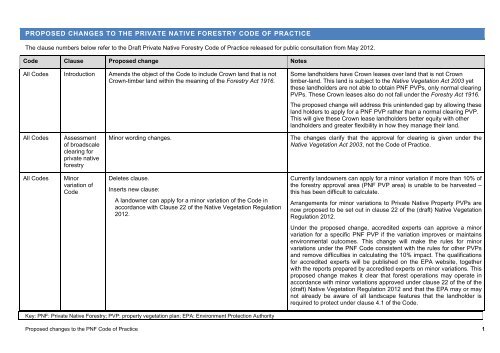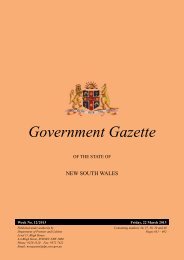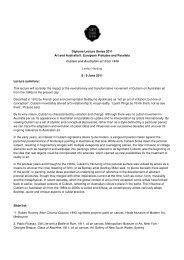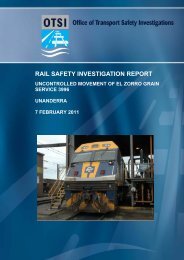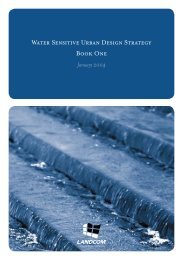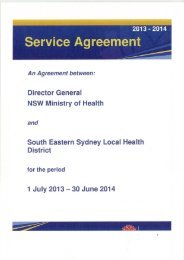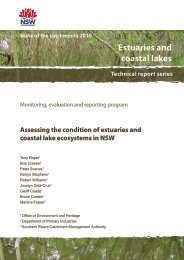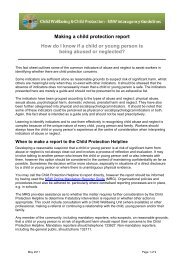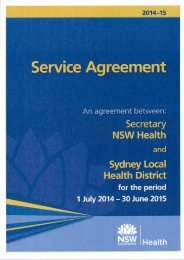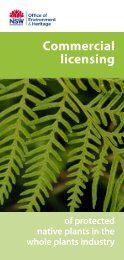Proposed changes to the Private Native Forestry Code of Practice
Proposed changes to the Private Native Forestry Code of Practice
Proposed changes to the Private Native Forestry Code of Practice
- No tags were found...
Create successful ePaper yourself
Turn your PDF publications into a flip-book with our unique Google optimized e-Paper software.
PROPOSED CHANGES TO THE PRIVATE NATIVE FORESTRY CODE OF PRACTICEThe clause numbers below refer <strong>to</strong> <strong>the</strong> Draft <strong>Private</strong> <strong>Native</strong> <strong>Forestry</strong> <strong>Code</strong> <strong>of</strong> <strong>Practice</strong> released for public consultation from May 2012.<strong>Code</strong> Clause <strong>Proposed</strong> change NotesAll <strong>Code</strong>s Introduction Amends <strong>the</strong> object <strong>of</strong> <strong>the</strong> <strong>Code</strong> <strong>to</strong> include Crown land that is notCrown-timber land within <strong>the</strong> meaning <strong>of</strong> <strong>the</strong> <strong>Forestry</strong> Act 1916.Some landholders have Crown leases over land that is not Crowntimber-land. This land is subject <strong>to</strong> <strong>the</strong> <strong>Native</strong> Vegetation Act 2003 yet<strong>the</strong>se landholders are not able <strong>to</strong> obtain PNF PVPs, only normal clearingPVPs. These Crown leases also do not fall under <strong>the</strong> <strong>Forestry</strong> Act 1916.The proposed change will address this unintended gap by allowing <strong>the</strong>seland holders <strong>to</strong> apply for a PNF PVP ra<strong>the</strong>r than a normal clearing PVP.This will give <strong>the</strong>se Crown lease landholders better equity with o<strong>the</strong>rlandholders and greater flexibility in how <strong>the</strong>y manage <strong>the</strong>ir land.All <strong>Code</strong>sAssessmen<strong>to</strong>f broadscaleclearing forprivate nativeforestryMinor wording <strong>changes</strong>.The <strong>changes</strong> clarify that <strong>the</strong> approval for clearing is given under <strong>the</strong><strong>Native</strong> Vegetation Act 2003, not <strong>the</strong> <strong>Code</strong> <strong>of</strong> <strong>Practice</strong>.All <strong>Code</strong>sMinorvariation <strong>of</strong><strong>Code</strong>Deletes clause.Inserts new clause:A landowner can apply for a minor variation <strong>of</strong> <strong>the</strong> <strong>Code</strong> inaccordance with Clause 22 <strong>of</strong> <strong>the</strong> <strong>Native</strong> Vegetation Regulation2012.Currently landowners can apply for a minor variation if more than 10% <strong>of</strong><strong>the</strong> forestry approval area (PNF PVP area) is unable <strong>to</strong> be harvested –this has been difficult <strong>to</strong> calculate.Arrangements for minor variations <strong>to</strong> <strong>Private</strong> <strong>Native</strong> Property PVPs arenow proposed <strong>to</strong> be set out in clause 22 <strong>of</strong> <strong>the</strong> (draft) <strong>Native</strong> VegetationRegulation 2012.Under <strong>the</strong> proposed change, accredited experts can approve a minorvariation for a specific PNF PVP if <strong>the</strong> variation improves or maintainsenvironmental outcomes. This change will make <strong>the</strong> rules for minorvariations under <strong>the</strong> PNF <strong>Code</strong> consistent with <strong>the</strong> rules for o<strong>the</strong>r PVPsand remove difficulties in calculating <strong>the</strong> 10% impact. The qualificationsfor accredited experts will be published on <strong>the</strong> EPA website, <strong>to</strong>ge<strong>the</strong>rwith <strong>the</strong> reports prepared by accredited experts on minor variations. Thisproposed change makes it clear that forest operations may operate inaccordance with minor variations approved under clause 22 <strong>of</strong> <strong>the</strong> <strong>of</strong> <strong>the</strong>(draft) <strong>Native</strong> Vegetation Regulation 2012 and that <strong>the</strong> EPA may or maynot already be aware <strong>of</strong> all landscape features that <strong>the</strong> landholder isrequired <strong>to</strong> protect under clause 4.1 <strong>of</strong> <strong>the</strong> <strong>Code</strong>.Key: PNF: <strong>Private</strong> <strong>Native</strong> <strong>Forestry</strong>; PVP: property vegetation plan; EPA: Environment Protection Authority<strong>Proposed</strong> <strong>changes</strong> <strong>to</strong> <strong>the</strong> PNF <strong>Code</strong> <strong>of</strong> <strong>Practice</strong> 1
<strong>Code</strong> Clause <strong>Proposed</strong> change NotesAll <strong>Code</strong>s 1 Amends clause (c):All <strong>Code</strong>s 2.1(5)(a)(ii) Amends sub-clause <strong>to</strong>:For <strong>the</strong> purpose <strong>of</strong> preparing a PVP and assisting <strong>the</strong> landownerin preparing <strong>the</strong> Forest Operation Plan in clause 2 below, <strong>the</strong>Environment Protection Authority (EPA) will provide <strong>the</strong>landowner with any available digital information it has in itspossession on landscape features (as identified in Table C insection 4.1) and any drainage features (as identified in Table Fin section 4.4 <strong>of</strong> this <strong>Code</strong>).recorded locations <strong>of</strong> any endangered populations or threatened(vulnerable, endangered and critically endangered) communitieslisted under <strong>the</strong> schedules <strong>of</strong> <strong>the</strong> Threatened SpeciesConservation Act 1995 and species in <strong>the</strong> Listed SpeciesEcological Prescriptions for Nor<strong>the</strong>rn NSW Forests / Sou<strong>the</strong>rnNSW Forests / River Red Gum Forests / Cypress and WesternHardwood Forests, which are set out in <strong>the</strong> Appendix <strong>to</strong> this<strong>Code</strong>.The proposed change expands on <strong>the</strong> nature <strong>of</strong> <strong>the</strong> information providedby <strong>the</strong> EPA. While mainly administrative in nature, <strong>the</strong> change clarifiesthat <strong>the</strong> information provided by <strong>the</strong> EPA is for information purposesonly, and should not be considered <strong>to</strong> be a complete survey <strong>of</strong> <strong>the</strong>features present on <strong>the</strong> landholder’s land.The proposed change aligns <strong>the</strong> <strong>Code</strong> with <strong>the</strong> Threatened SpeciesConservation Act 1995. Under <strong>the</strong> Act, threatened ecologicalcommunities fall in<strong>to</strong> three categories – Critically Endangered EcologicalCommunities, Endangered Ecological Communities, and VulnerableEcological Communities. When <strong>the</strong> <strong>Code</strong> was gazetted in August 2007,only Endangered Ecological Communities were listed.The current <strong>Code</strong> allows <strong>Forestry</strong> operations in Endangered EcologicalCommunities (with an Ecological Harvesting Plan approved by <strong>the</strong> ChiefRegula<strong>to</strong>r EPA), prohibits <strong>Forestry</strong> operations in Vulnerable EcologicalCommunities, and is silent on Critically Endangered EcologicalCommunities.Nor<strong>the</strong>rnSou<strong>the</strong>rnCypress2.1(5)(b)(ii)Amends sub-clause <strong>to</strong>:a description <strong>of</strong> <strong>the</strong> forest, including its disturbance his<strong>to</strong>ry andcurrent conditionThe proposed change simplifies <strong>the</strong> written Forest Operation Plan bydeleting <strong>the</strong> requirement <strong>to</strong> describe forest types and overs<strong>to</strong>rey speciescomposition. The change is consistent with <strong>the</strong> current wording <strong>of</strong> <strong>the</strong>River Red Gums <strong>Code</strong> <strong>of</strong> <strong>Practice</strong>.All <strong>Code</strong>s 2.1(6) Inserts new sub-clause:The provision <strong>of</strong> available digital information by <strong>the</strong> EPA onlandscape features (as identified in Table C in section 4.1) anddrainage features (as identified in Table F in section 4.4) doesnot reduce <strong>the</strong> landowner’s obligation <strong>to</strong> independently identifyand map in <strong>the</strong> Forest Operations Plan additional relevantlandscape and drainage features that may be present on <strong>the</strong>land. The EPA does not guarantee that <strong>the</strong> digital information itprovides is a complete list <strong>of</strong> <strong>the</strong>se features on <strong>the</strong> land.The proposed change clarifies landholder responsibilities <strong>to</strong> identify andprotect landscape features on <strong>the</strong>ir property by making it clear thatinformation provided by <strong>the</strong> EPA does not indemnify <strong>the</strong> landholder fromexercising due diligence in relation <strong>to</strong> all landscape features identified inTable C in section 4.1.Key: PNF: <strong>Private</strong> <strong>Native</strong> <strong>Forestry</strong>; PVP: property vegetation plan; EPA: Environment Protection Authority<strong>Proposed</strong> <strong>changes</strong> <strong>to</strong> <strong>the</strong> PNF <strong>Code</strong> <strong>of</strong> <strong>Practice</strong> 2
<strong>Code</strong> Clause <strong>Proposed</strong> change NotesAll <strong>Code</strong>s 2.1(7) Inserts new sub-clause:All <strong>Code</strong>s 2.2 Deletes current clause.The landowner must have <strong>the</strong> Forest Operation Plan approvedby an ’accredited expert’ where it relates <strong>to</strong> forest operations ina vulnerable ecological community (see Table C in section 4.1).Inserts new clause:(1) The landowner must notify <strong>the</strong> EPA <strong>of</strong> <strong>the</strong>commencement or cessation <strong>of</strong> <strong>the</strong> following fores<strong>to</strong>perations:(a) any activity carried out under clauses 3.1 or 3.2 <strong>of</strong> <strong>the</strong><strong>Code</strong> or;(b) any activity carried out under clause 5.2 <strong>of</strong> <strong>the</strong> <strong>Code</strong>;or(c) any activity carried out under clause 5.1that is for <strong>the</strong>purpose <strong>of</strong> carrying out activities under clauses 3.1,3.2 or 5.2 <strong>of</strong> <strong>the</strong> <strong>Code</strong>.(2) In respect <strong>of</strong> commencement <strong>of</strong> forest operations,notification must be provided <strong>to</strong> <strong>the</strong> EPA within <strong>the</strong> periodstarting 14 days before commencement <strong>of</strong> <strong>the</strong> relevantforest operation and 3 days after commencement <strong>of</strong> tha<strong>to</strong>peration.(3) In respect <strong>of</strong> cessation <strong>of</strong> forest operations, notificationmust be provided within 14 days after <strong>the</strong> relevant fores<strong>to</strong>peration ceases. A forest operation is deemed <strong>to</strong> ceaseif no fur<strong>the</strong>r forest operations are planned for a period <strong>of</strong>3 months or more.(4) Notification is <strong>to</strong> be provided by <strong>the</strong> landowner in one <strong>of</strong><strong>the</strong> following approved formats:(a) Provision <strong>of</strong> notification information in a phone-call <strong>to</strong><strong>the</strong> Environment Line (131 555) or <strong>the</strong> local EPA<strong>of</strong>fice during standard <strong>of</strong>fice hours.(b) Provision <strong>of</strong> notification information in person at <strong>the</strong>EPA <strong>of</strong>fice during standard <strong>of</strong>fice hours.(c) Provision <strong>of</strong> notification information on a formapproved by <strong>the</strong> EPA and submitted by fax, mail oremail <strong>to</strong> a location specified on <strong>the</strong> form. The EPA willThe proposed change clarifies that where landholder plans <strong>to</strong> conductforestry operations in a vulnerable ecological community <strong>the</strong> ForestOperations Plan must be approved by an accredited expert. See TableC in section 4.1 for more information.The proposed change cuts red-tape for landowners by removing <strong>the</strong>current requirement <strong>to</strong> provide <strong>the</strong> EPA with an annual report on loggingoperations.Landowners will now be required <strong>to</strong> notify <strong>the</strong> EPA <strong>of</strong> <strong>the</strong>commencement and finalisation <strong>of</strong> forestry operations. Notification willbe possible up <strong>to</strong> 14 days before or up <strong>to</strong> 3 days after a forestryoperation is due <strong>to</strong> take place and again within 2 weeks after a forestryoperation is completed. If a landholder does not carry out any fores<strong>to</strong>perations in a given year, <strong>the</strong>y will not need <strong>to</strong> notify <strong>the</strong> EPA at all.Landowners will be given a range <strong>of</strong> flexible options for notificationincluding: phoning Environment Line including notifying in person at <strong>the</strong>local EPA Office; by fax, email, or mail or on <strong>the</strong> web using a form which<strong>the</strong> EPA will develop.The clause specifies <strong>the</strong> information a landholder will be required <strong>to</strong>provide at <strong>the</strong> time <strong>of</strong> notification including <strong>the</strong> PNF PVP number,proposed dates <strong>of</strong> forest operations, <strong>the</strong> type <strong>of</strong> operation, and contactdetails for any contrac<strong>to</strong>rs. This is less than <strong>the</strong> information currentlyrequired <strong>to</strong> be provided in an annual report.The proposed change will also provide EPA with more up-<strong>to</strong>-dateinformation <strong>to</strong> assist with targeting compliance and regula<strong>to</strong>ry activities.Key: PNF: <strong>Private</strong> <strong>Native</strong> <strong>Forestry</strong>; PVP: property vegetation plan; EPA: Environment Protection Authority<strong>Proposed</strong> <strong>changes</strong> <strong>to</strong> <strong>the</strong> PNF <strong>Code</strong> <strong>of</strong> <strong>Practice</strong> 3
<strong>Code</strong> Clause <strong>Proposed</strong> change Notesacknowledge <strong>the</strong> receipt <strong>of</strong> this notification within oneworking week <strong>of</strong> its receipt.(d) Provision <strong>of</strong> notification information using <strong>the</strong> webbasedform available on <strong>the</strong> EPA website. The EPAwill provide an electronic receipt <strong>to</strong> <strong>the</strong> landowneracknowledging that notification has been received.(5) The following information must be included in anycommencement notification <strong>to</strong> <strong>the</strong> EPA:(a) <strong>the</strong> PNF PVP number(b) <strong>the</strong> proposed or actual commencement date <strong>of</strong> <strong>the</strong>relevant forest operation(c) <strong>the</strong> type and location <strong>of</strong> <strong>the</strong> forest operation beingcommenced(d) <strong>the</strong> estimated time <strong>the</strong> forest operation will take <strong>to</strong>complete(e) name and contact details <strong>of</strong> <strong>the</strong> principal contrac<strong>to</strong>r (ifany) who will be undertaking <strong>the</strong> forest operation.(6) The following information must be included in anycessation notification <strong>to</strong> <strong>the</strong> EPA:(a) <strong>the</strong> PNF PVP number(b) <strong>the</strong> type and location <strong>of</strong> <strong>the</strong> forest operations that areceasing(c) <strong>the</strong> date <strong>the</strong> forest operation ceased.Nor<strong>the</strong>rnSou<strong>the</strong>rnRiver RedGum3.1(2) Amends sub-clause <strong>to</strong>:The minimum stand basal areas are <strong>to</strong> be calculated inaccordance with <strong>the</strong> Techniques for measuring stand basalarea, available at www.environment.nsw.gov.au/pnf.The proposed change updates <strong>the</strong> name <strong>of</strong> <strong>the</strong> reference document thatshould be used <strong>to</strong> measure stand basal area, available on <strong>the</strong> EPAwebsite.Nor<strong>the</strong>rn 3.1 Note Moves <strong>the</strong> stand basal area note from <strong>the</strong> end <strong>of</strong> clause 3.2 <strong>to</strong> amore appropriate position in <strong>the</strong> <strong>Code</strong> (at <strong>the</strong> end <strong>of</strong> clause 3.1).The proposed change is administrative in nature.Nor<strong>the</strong>rnSou<strong>the</strong>rnRiver RedGum3.2 Note Amends note <strong>to</strong>:For <strong>the</strong> purposes <strong>of</strong> selecting an appropriate silviculturalmanagement regime, reference should be made <strong>to</strong> <strong>the</strong>Silvicultural guidelines: <strong>Private</strong> <strong>Native</strong> <strong>Forestry</strong> <strong>Code</strong> <strong>of</strong><strong>Practice</strong>, available at www.environment.nsw.gov.au/pnf.The proposed change updates <strong>the</strong> name <strong>of</strong> <strong>the</strong> reference document thatshould be used for selecting an appropriate silvicultural managementregime, available on <strong>the</strong> EPA website.Key: PNF: <strong>Private</strong> <strong>Native</strong> <strong>Forestry</strong>; PVP: property vegetation plan; EPA: Environment Protection Authority<strong>Proposed</strong> <strong>changes</strong> <strong>to</strong> <strong>the</strong> PNF <strong>Code</strong> <strong>of</strong> <strong>Practice</strong> 4
<strong>Code</strong> Clause <strong>Proposed</strong> change NotesAll <strong>Code</strong>s 3.3 Note Amends note <strong>to</strong> include a reference <strong>to</strong> <strong>the</strong> document that explains<strong>the</strong> methodology for assessing regeneration and s<strong>to</strong>cking in arepresentative number <strong>of</strong> plots.Deletes text:Plots will be found <strong>to</strong> be ei<strong>the</strong>r s<strong>to</strong>cked or uns<strong>to</strong>cked.All <strong>Code</strong>s 4.1 Replaces current sub-clause (2):Old growth and rainforest will be identified according <strong>to</strong> <strong>the</strong>pro<strong>to</strong>col approved by <strong>the</strong> Minister for <strong>the</strong> Environment availableat www.environment.nsw.gov.au/pnf.The proposed <strong>changes</strong> clarify <strong>the</strong> reference document available on <strong>the</strong>EPA website that should be used when assessing regeneration ands<strong>to</strong>cking, and removes repetition and ambiguity.The proposed change is administrative in nature.Replaces current sub-clause (3):Before forestry operations can commence landowners mustexercise ‘due diligence’ in relation <strong>to</strong> Aboriginal objects, inaccordance with <strong>the</strong> Due diligence code <strong>of</strong> practice forprotection <strong>of</strong> Aboriginal objects, available atwww.environment.nsw.gov.au/conservation/aboriginalculture.htm.The proposed change requires landowners <strong>to</strong> exercise ‘due diligence’ inrelation <strong>to</strong> Aboriginal objects. This due diligence must be exercised inaccordance with <strong>the</strong> Due Diligence <strong>Code</strong> <strong>of</strong> <strong>Practice</strong> for <strong>the</strong> Protection <strong>of</strong>Aboriginal objects. This document can be found atwww.environment.nsw.gov.au/resources/cultureheritage/ddcop/ddcop-DII.pdfKey: PNF: <strong>Private</strong> <strong>Native</strong> <strong>Forestry</strong>; PVP: property vegetation plan; EPA: Environment Protection Authority<strong>Proposed</strong> <strong>changes</strong> <strong>to</strong> <strong>the</strong> PNF <strong>Code</strong> <strong>of</strong> <strong>Practice</strong> 5
<strong>Code</strong> Clause <strong>Proposed</strong> change NotesAll <strong>Code</strong>s Table C Inserts new row:Landscape featureCritically endangeredecological communities listedin <strong>the</strong> Threatened SpeciesConservation Act 1995 at <strong>the</strong>date <strong>the</strong> private native forestryPVP is approved by <strong>the</strong>MinisterOperational ConditionForest operations may no<strong>to</strong>ccur, except that existingroads may be maintained.Amends operation prescription for vulnerable ecologicalcommunities:Landscape featureVulnerable ecologicalcommunities listed in <strong>the</strong>Threatened SpeciesConservation Act 1995 at <strong>the</strong>date <strong>the</strong> private native forestryPVP is approved by <strong>the</strong>MinisterOperational ConditionForest operations must no<strong>to</strong>ccur in vulnerable ecologicalcommunities, except under aForest Operation Planapproved by an accreditedexpert and that existing roadsmay be maintained.The proposed change aligns protection for critically endangeredcommunities <strong>to</strong> align with Threatened Species Conservation Act 1995.Critically endangered ecological communities were not listed in <strong>the</strong>Threatened Species Conservation Act 1995 at <strong>the</strong> time <strong>the</strong> PNF <strong>Code</strong>was gazetted in August 2007.The proposed <strong>changes</strong> also align <strong>the</strong> treatment <strong>of</strong> threatened ecologicalcommunities <strong>to</strong> <strong>the</strong> potential risks. <strong>Forestry</strong> operations are not allowed inCritically Endangered Ecological Communities, <strong>the</strong> status quo remainsfor Endangered Ecological Communities and forestry operations arepermitted in Vulnerable Ecological Communities with a <strong>Forestry</strong>Operation Plan approved by an accredited expert (see clause 22 <strong>of</strong> <strong>the</strong>(draft) <strong>Native</strong> Vegetation Regulation 2012).Accredited experts will be required <strong>to</strong> prepare reports assessing <strong>the</strong>impact <strong>of</strong> forestry in a Vulnerable Ecological Community. These reportswill be made available on <strong>the</strong> EPA website as well as <strong>the</strong> qualificationstandards for accredited experts.Cypress Table C Inserts new row:Landscape featureSteep slopesOperational ConditionForest operations must no<strong>to</strong>ccur on slopes greater than30 degrees, except that: existing roads and tracksmay be maintained new roads and tracks maybe constructed subject <strong>to</strong>conditions in clause5.1(18) <strong>of</strong> <strong>the</strong> <strong>Code</strong>.The proposed change standardises <strong>the</strong> provisions for Cypress andWestern Hardwood <strong>Code</strong> with <strong>the</strong> o<strong>the</strong>r <strong>Code</strong>s. Some WesternHardwood Forests occur on ground with a slope greater than30 degrees.Key: PNF: <strong>Private</strong> <strong>Native</strong> <strong>Forestry</strong>; PVP: property vegetation plan; EPA: Environment Protection Authority<strong>Proposed</strong> <strong>changes</strong> <strong>to</strong> <strong>the</strong> PNF <strong>Code</strong> <strong>of</strong> <strong>Practice</strong> 6
<strong>Code</strong> Clause <strong>Proposed</strong> change NotesCypress Table C Deletes point:Aboriginal scarred or carved treeCypress Table D Inserts new operational conditionAll <strong>Code</strong>sTable D and4.3(3)(b)Broad forest typesOperational ConditionWestern hardwood A minimum <strong>of</strong> 6 feed treesper 2 hectares should beretained where available. All feed trees that havemarks or ‘V’ notches fromsap-feeding mammalsmust be retained.Inserts new operational condition for Cypress and WesternHardwoods:Five mature female and five mature male trees <strong>of</strong> <strong>the</strong> genusAllocasuarina (forest oak) every two hectares, where available,plus any Allocasuarina that has crushed cones beneath it.The proposed change removes unnecessary text in <strong>the</strong> clause in <strong>the</strong>clause as forestry operations around Aboriginal scarred or carved treesare already proscribed in <strong>the</strong> following point.The proposed change standardises <strong>the</strong> provisions for <strong>the</strong> Cypress andWestern Hardwood <strong>Code</strong> in<strong>to</strong> line with <strong>the</strong> o<strong>the</strong>r <strong>Code</strong>s. WesternHardwood forests provide critical habitat for animals which contribute <strong>to</strong>positive biodiversity outcomes such pest control, pollination and seeddispersal.Under <strong>the</strong> current <strong>Code</strong>, Allocasuarina spp. (forest oak) is classified as aprotected tree (clause 4.3(3)(b)), that must be protected from forestryoperations.The proposed change aligns <strong>the</strong> standards for protection <strong>of</strong> forest oakwith those that apply on <strong>the</strong> Crown forestry estate. Forest oak is nowproposed <strong>to</strong> be subject <strong>to</strong> a tree retention provision <strong>to</strong> allow for moreflexible harvesting for cottage industries whilst maintaining anappropriate number <strong>of</strong> <strong>the</strong> trees as feed trees.By retaining all Allocasuarina spp. with crushed cones beneath <strong>the</strong>m,high quality feed trees for birds such as <strong>the</strong> glossy black cocka<strong>to</strong>o aremore likely <strong>to</strong> be retained. The glossy black cocka<strong>to</strong>o is listed as avulnerable species under <strong>the</strong> Threatened Species Conservation Act2005.Nor<strong>the</strong>rnSou<strong>the</strong>rnCypressTable FAmends <strong>the</strong> reference <strong>to</strong> <strong>the</strong> stream order figure, which has beenmoved from <strong>the</strong> Appendix <strong>to</strong> Section 4.4 (Drainage featureprotection).The proposed change is administrative in nature.Key: PNF: <strong>Private</strong> <strong>Native</strong> <strong>Forestry</strong>; PVP: property vegetation plan; EPA: Environment Protection Authority<strong>Proposed</strong> <strong>changes</strong> <strong>to</strong> <strong>the</strong> PNF <strong>Code</strong> <strong>of</strong> <strong>Practice</strong> 7
<strong>Code</strong> Clause <strong>Proposed</strong> change NotesNor<strong>the</strong>rnSou<strong>the</strong>rnRiver RedGum4.4(2) Deletes <strong>the</strong> word ‘limited’ from <strong>the</strong> second sentence. The proposed change is administrative in nature. The sub-clause setsout <strong>the</strong> limitations that apply <strong>to</strong> forest operations carried out in riparianbuffer zones ((a) <strong>to</strong> (g)), so <strong>the</strong> term ‘limited’ is superfluous.Nor<strong>the</strong>rnSou<strong>the</strong>rn4.4(3)[4.4(2) inCypress andWesternHardwoodForests <strong>Code</strong>]Amends <strong>the</strong> reference <strong>to</strong> <strong>the</strong> stream order figure, which has beenmoved from <strong>the</strong> Appendix <strong>to</strong> Section 4.4 (Drainage featureprotection).The proposed change is administrative in nature.Cypress 4.4(7) Deletes sub-clause,Inserts new sub-clause:Drainage line buffer zones must be applied <strong>to</strong> all unmappeddrainage lines. For <strong>the</strong> purposes <strong>of</strong> this clause, drainage linebuffer zones are areas within, and under 10 metres <strong>of</strong>, <strong>the</strong> <strong>to</strong>pedge <strong>of</strong> <strong>the</strong> bank <strong>of</strong> any unmapped drainage line.The proposed change standardises <strong>the</strong> provisions for drainage linebuffer zones in <strong>the</strong> Cypress <strong>Code</strong> with <strong>the</strong> o<strong>the</strong>r three <strong>Code</strong>s. Nosubstantive change is proposed <strong>to</strong> what can be done in drainage linebuffer zones.References <strong>to</strong> ‘walkover techniques’ moved <strong>to</strong> sub-clause (8). Theterminology for ‘machinery exclusion zone’ has been changed <strong>to</strong>‘drainage line buffer zone’.Nor<strong>the</strong>rnSou<strong>the</strong>rn4.4(8) Deletes current sub-clause.Inserts new sub-clause:Drainage line buffer zones as specified in <strong>the</strong> Glossary <strong>to</strong> this<strong>Code</strong> must be applied <strong>to</strong> all unmapped drainage lines.The proposed change rephrases <strong>the</strong> sub-clause for improved clarity. Nosubstantive change is proposed <strong>to</strong> what can be done in drainage linebuffer zones.The proposed change updates <strong>the</strong> terminology from ‘machineryexclusion zone’ <strong>to</strong> ‘drainage line buffer zone’ and refers landholders <strong>to</strong><strong>the</strong> Glossary for <strong>the</strong> relevant drainage line buffer zones.Key: PNF: <strong>Private</strong> <strong>Native</strong> <strong>Forestry</strong>; PVP: property vegetation plan; EPA: Environment Protection Authority<strong>Proposed</strong> <strong>changes</strong> <strong>to</strong> <strong>the</strong> PNF <strong>Code</strong> <strong>of</strong> <strong>Practice</strong> 8
<strong>Code</strong> Clause <strong>Proposed</strong> change NotesNor<strong>the</strong>rnSou<strong>the</strong>rnCypress4.4(9) and(10)[4.4(8) inCypress andWesternHardwoodForests <strong>Code</strong>]Deletes sub-clauses (9) and (10).Inserts new sub-clause (9):Forest operations may occur in drainage line buffer zonessubject <strong>to</strong> <strong>the</strong> following limitations:(a) machinery, using walkover techniques, may extract logsfrom any area within a drainage line buffer zone(b) felling is directed away from <strong>the</strong> drainage lineThe proposed change rephrases <strong>the</strong> sub-clause for improved clarity. Nosubstantive change is proposed <strong>to</strong> what can be done in drainage linebuffer zones.(c) any furrows resulting from log removal are treated <strong>to</strong>prevent concentration <strong>of</strong> water flow(d) groundcover (including grasses, herbs, and forest litter) isretained or groundcover similar <strong>to</strong> groundcover in <strong>the</strong>surrounding area is artificially reinstated.Nor<strong>the</strong>rnSou<strong>the</strong>rnCypress4.4(11) (d)[4.4(10) inCypress andWesternHardwoodForests <strong>Code</strong>]Inserts new sub-clause:(d) <strong>the</strong> new roads and re-opened old roads comply withconditions set out in section 5 <strong>of</strong> this <strong>Code</strong>The proposed change makes it clear that <strong>the</strong> provisions <strong>of</strong> Section 5 <strong>of</strong><strong>the</strong> <strong>Code</strong> (Construction and maintenance <strong>of</strong> forest infrastructure) apply<strong>to</strong> constructing new roads and re-opening roads in riparian buffer zones.Nor<strong>the</strong>rnSou<strong>the</strong>rnNor<strong>the</strong>rnSou<strong>the</strong>rnCypress4.4(12) Deletes sub-clause. The proposed change is administrative in nature as <strong>the</strong>se specificationsare now covered in clause 4.4(7).5.1(4) Deletes <strong>the</strong> words ‘must be <strong>to</strong> <strong>the</strong> minimum extent necessary’ The proposed change removes unnecessary repetition.Nor<strong>the</strong>rnSou<strong>the</strong>rnCypress5.1(5) Adds references <strong>to</strong> Table C in section 4.1 and Table F in Section4.4The proposed change is administrative in nature.Key: PNF: <strong>Private</strong> <strong>Native</strong> <strong>Forestry</strong>; PVP: property vegetation plan; EPA: Environment Protection Authority<strong>Proposed</strong> <strong>changes</strong> <strong>to</strong> <strong>the</strong> PNF <strong>Code</strong> <strong>of</strong> <strong>Practice</strong> 9
<strong>Code</strong> Clause <strong>Proposed</strong> change NotesAPPENDIXAll <strong>Code</strong>s The stream order schematic diagram has been moved from <strong>the</strong>Appendix <strong>to</strong> Section 4.4 Drainage Feature Protection.APPENDIX: LISTED SPECIES ECOLOGICAL PRESCRIPTIONSNor<strong>the</strong>rnAmphibiansInserts new listed species:Yellow-spotted frog (Li<strong>to</strong>ria castanea)CMAs for application <strong>of</strong> prescription Border Rivers/Gwydir,Central West, Lachlan, Murrumbidgee, Nor<strong>the</strong>rn Rivers andSou<strong>the</strong>rn RiversPrescription Where <strong>the</strong>re is a record <strong>of</strong> <strong>the</strong> yellow-spotted treefrog in an area <strong>to</strong> be harvested or within 200 metres outside <strong>the</strong>boundary <strong>of</strong> <strong>the</strong> area <strong>to</strong> be harvested, <strong>the</strong> following must apply:(a) An exclusion zone <strong>of</strong> 30 metres wide must be implementedon both sides <strong>of</strong> all streams (including first-order, secondorderand above streams – see Figure 1) in <strong>the</strong> forestedarea within 200 metres <strong>of</strong> <strong>the</strong> record.(b) The width <strong>of</strong> <strong>the</strong> exclusion zone must be measured from<strong>the</strong> <strong>to</strong>p <strong>of</strong> <strong>the</strong> bank <strong>of</strong> <strong>the</strong> incised channel, or, where <strong>the</strong>reis no defined bank, from <strong>the</strong> edge <strong>of</strong> <strong>the</strong> channel.The proposed change is administrative in nature.The proposed change includes appropriate prescriptions for <strong>the</strong> yellowspottedtree frog (Li<strong>to</strong>ria castanea) which was listed as criticallyendangered in 2009 under <strong>the</strong> Threatened Species Conservation Act2005.MammalsMammals –Table I: Koalafood treesSpecies removed from prescription:Large-footed myotis (Myotis adversus)Inserts new listed species:River red gum (Eucalyptus camadulensis)The proposed change removed <strong>the</strong> large-footed myotis (Myotisadversus) from <strong>the</strong> Appendix.The large-footed myotis’s habitat is strictly bounded by proximity <strong>to</strong>permanent water. As such, <strong>the</strong> bat is considered <strong>to</strong> be sufficientlyprotected by <strong>the</strong> prescriptions already in place for protection <strong>of</strong> streamsunder section 4.4 <strong>of</strong> <strong>the</strong> <strong>Code</strong>.The proposed change adds appropriate prescriptions for river red gum(Eucalyptus camaldulensis) which is a primary food tree in KoalaManagement Area 5: Central and Sou<strong>the</strong>rn Tablelands in <strong>the</strong> RecoveryPlan for <strong>the</strong> Koala 2008 available athttp://www.environment.nsw.gov.au/resources/threatenedspecies/08450krp.pdfKey: PNF: <strong>Private</strong> <strong>Native</strong> <strong>Forestry</strong>; PVP: property vegetation plan; EPA: Environment Protection Authority<strong>Proposed</strong> <strong>changes</strong> <strong>to</strong> <strong>the</strong> PNF <strong>Code</strong> <strong>of</strong> <strong>Practice</strong> 10
<strong>Code</strong> Clause <strong>Proposed</strong> change NotesSpecies name corrected:The proposed change is administrative in nature.BirdsThreatenedFlora –specificprescriptionsTable JWestern grey box (Eucalyptus macrocarpa) [E. microcarpa]Prescription has been limited <strong>to</strong> two subspecies:Red-tailed black-cocka<strong>to</strong>o (Calyp<strong>to</strong>rhynchus banksiisamueli, C. banksii banksii)Inserts three new listed species:Flame robin (Petroica phoenicea), scarlet robin (Petriocaboodang) and hooded robin (Melanodryas cucullatacucullata)CMAs for application <strong>of</strong> prescription All except for WesternPrescription No forest operations are permitted within a50-metre radius <strong>of</strong> all flame, scarlet and hooded robin nests.Inserts new listed species:Red goshawk (Erythrotriorchis radiatus)CMAs for application <strong>of</strong> prescription AllPrescription No harvesting within a 100 metres radiusexclusion zone around all red goshawk nests.Conditioned changed:MacNutt’s wattle (Acacia macnuttiana)CMA Border Rivers–Gwydir, Nor<strong>the</strong>rn RiversCondition Updated from B (20 m exclusion zone around allindividuals) <strong>to</strong> E (90% <strong>of</strong> individuals must be protected fromdamage by use <strong>of</strong> techniques such as directional felling).The proposed change includes appropriate prescriptions for <strong>the</strong> redtailedblack-cocka<strong>to</strong>o (inland subspecies) (Calyp<strong>to</strong>rhynchus banksiisamueli) which was listed as vulnerable in 2009, and <strong>the</strong> red-tailedblack-cocka<strong>to</strong>o (coastal subspecies) (Calyp<strong>to</strong>rhynchus banksii banksii)which was listed as critically endangered under <strong>the</strong> Threatened SpeciesConservation Act 2005.The proposed change includes appropriate prescriptions for <strong>the</strong> flamerobin (Petroica phoenicea) which was listed as vulnerable in 2010, <strong>the</strong>scarlet robin (Petroica boodang) which was listed as vulnerable in 2010,and <strong>the</strong> hooded robin (Melanodryas cucullata cucullata) which was listedas vulnerable in 2001under <strong>the</strong> Threatened Species Conservation Act2005.The proposed change includes appropriate prescriptions for <strong>the</strong> redgoshawk (Erythrotriorchis radiatus) which was listed as criticallyendangered in 2009 under <strong>the</strong> Threatened Species Conservation Act2005.The proposed change is a more practical approach <strong>to</strong> facilitatecooperation with <strong>the</strong> <strong>Code</strong>.Protection <strong>of</strong> 90% <strong>of</strong> individual species is considered <strong>to</strong> be a moreappropriate given <strong>the</strong> semi-prolific nature <strong>of</strong> regeneration <strong>of</strong> this species.Key: PNF: <strong>Private</strong> <strong>Native</strong> <strong>Forestry</strong>; PVP: property vegetation plan; EPA: Environment Protection Authority<strong>Proposed</strong> <strong>changes</strong> <strong>to</strong> <strong>the</strong> PNF <strong>Code</strong> <strong>of</strong> <strong>Practice</strong> 11
<strong>Code</strong> Clause <strong>Proposed</strong> change NotesUpdated <strong>to</strong> reflect new species name, updated condition:Bertya opponens [Bertya sp. Cobar-Coolabah]Condition Updated from A (50 m exclusion zone around allindividuals) <strong>to</strong> B (20 m exclusion zone around all individuals).Condition changed:Slaty red gum (Eucalyptus glaucina), nor<strong>the</strong>rn populationCMA Nor<strong>the</strong>rn RiversCondition Updated from G (exclusion <strong>of</strong> forestry activities from100% <strong>of</strong> individuals) <strong>to</strong> E (90% <strong>of</strong> individuals must be protectedfrom damage by use <strong>of</strong> techniques such as directional felling).The proposed change is a more practical approach <strong>to</strong> facilitatecooperation with <strong>the</strong> <strong>Code</strong>.The proposed change is a more practical approach <strong>to</strong> facilitatecooperation with <strong>the</strong> <strong>Code</strong>.Protection <strong>of</strong> 90% <strong>of</strong> individual species is considered <strong>to</strong> be a moreappropriate given <strong>the</strong> nor<strong>the</strong>rn meta population (as opposed <strong>to</strong> <strong>the</strong>sou<strong>the</strong>rn and central meta populations) is typically a larger and healthierstand that regenerates easily in disturbed areas.Inserts newlisted species:Banksia conferta subsp. confertaCMA Nor<strong>the</strong>rn RiversCondition HRed helmet orchid (Corybas dowlingii)CMA Hunter–Central RiversCondition EPale yellow doubletail (Diuris flavescens)CMA Hunter–Central RiversCondition BBlack gum (Eucalyptus aggregata)CMA Central West, Hawkesbury/Nepean,Lachlan, Murrumbidgee, Sou<strong>the</strong>rn RiversCondition EThe proposed change includes appropriate prescriptions for Banksiaconferta A.S.George subsp. conferta which was listed as criticallyendangered in 2007 under <strong>the</strong> Threatened Species Conservation Act2005.The proposed change includes appropriate prescriptions for <strong>the</strong> redhelmet orchid (Corybas dowlingii) which was listed as endangered in2007 under <strong>the</strong> Threatened Species Conservation Act 2005.The proposed change includes appropriate prescriptions for <strong>the</strong> paleyellow doubletail (Diuris flavescens) which was listed as criticallyendangered in 2008 under <strong>the</strong> Threatened Species Conservation Act2005.The proposed change includes appropriate prescriptions for black gum(Eucalyptus aggregata) which was listed as vulnerable in 2010 under <strong>the</strong>Threatened Species Conservation Act 2005.Key: PNF: <strong>Private</strong> <strong>Native</strong> <strong>Forestry</strong>; PVP: property vegetation plan; EPA: Environment Protection Authority<strong>Proposed</strong> <strong>changes</strong> <strong>to</strong> <strong>the</strong> PNF <strong>Code</strong> <strong>of</strong> <strong>Practice</strong> 12
<strong>Code</strong> Clause <strong>Proposed</strong> change NotesDelicate pomaderris (Pomaderris delicata)CMA Hawkesbury–Nepean, Sou<strong>the</strong>rn RiversCondition BDenman pomaderris (Pomaderris reperta)CMA Hunter–Central RiversCondition BSlaty leek orchid (Prasophyllum fuscum)CMA Hawkesbury–Nepean, Hunter–CentralRivers, Sydney MetroCondition BTephrosia filipesCMA Nor<strong>the</strong>rn RiversCondition EWyong sun orchid (Thelymitra sp.Adorata)CMA Hunter–Central RiversCondition ETylophora linearisCMA Border Rivers–Gwydir, Central West,NamoiCondition EThe proposed change includes appropriate prescriptions for delicatepomaderris (Pomaderris delicata) which was listed as endangered in2002 under <strong>the</strong> Threatened Species Conservation Act 2005.The proposed change includes appropriate prescriptions for denmanpomaderris (Pomaderris reperta) which was listed as criticallyendangered in 2010 under <strong>the</strong> Threatened Species Conservation Act2005.The proposed change includes appropriate prescriptions for <strong>the</strong> slatyleek orchid (Prasophyllum fuscum R.Br. sens. str.) which was listed ascritically endangered in 2009 under <strong>the</strong> Threatened SpeciesConservation Act 2005.The proposed change includes appropriate prescriptions for Tephrosiafilipes which was listed as vulnerable in 2009 under <strong>the</strong> ThreatenedSpecies Conservation Act 2005.The proposed change includes appropriate prescriptions for <strong>the</strong> Wyongsun orchid (Thelymitra sp. 'Adorata') which was listed as criticallyendangered in 2008 under <strong>the</strong> Threatened Species Conservation Act2005.The proposed change includes appropriate prescriptions for Tylophoralinearis which was listed as vulnerable in 2008 under <strong>the</strong> ThreatenedSpecies Conservation Act 2005.Key: PNF: <strong>Private</strong> <strong>Native</strong> <strong>Forestry</strong>; PVP: property vegetation plan; EPA: Environment Protection Authority<strong>Proposed</strong> <strong>changes</strong> <strong>to</strong> <strong>the</strong> PNF <strong>Code</strong> <strong>of</strong> <strong>Practice</strong> 13
<strong>Code</strong> Clause <strong>Proposed</strong> change NotesSou<strong>the</strong>rnAmphibiansInserts new listed species:Spotted tree frog (Li<strong>to</strong>ria spenceri)CMAs for application <strong>of</strong> prescription MurrayThe proposed change includes appropriate prescriptions for <strong>the</strong> spottedtree frog (Li<strong>to</strong>ria spenceri) which was listed as critically endangered in2009 under <strong>the</strong> Threatened Species Conservation Act 2005.Prescription Where <strong>the</strong>re is a record <strong>of</strong> <strong>the</strong> spotted frog in anarea <strong>to</strong> be harvested or within 200 metres outside <strong>the</strong> boundary<strong>of</strong> <strong>the</strong> area <strong>to</strong> be harvested, <strong>the</strong> following must apply:An exclusion zone <strong>of</strong> 30 metres wide must be implemented onboth sides <strong>of</strong> all streams (including 1st and 2nd order and abovestreams – see Figure 1) within <strong>the</strong> forested area within200 metres <strong>of</strong> <strong>the</strong> record.The width <strong>of</strong> exclusion zone must be measured from <strong>the</strong> <strong>to</strong>p <strong>of</strong><strong>the</strong> bank <strong>of</strong> <strong>the</strong> incised channel, or, where <strong>the</strong>re is no definedbank, from <strong>the</strong> edge <strong>of</strong> <strong>the</strong> channel.Inserts new listed species:Yellow-spotted tree frog (Li<strong>to</strong>ria castanea)CMAs for application <strong>of</strong> prescription Border Rivers/Gwydir,Central West, Lachlan, Murrumbidgee, Nor<strong>the</strong>rn Rivers andSou<strong>the</strong>rn RiversThe proposed change includes appropriate prescriptions for <strong>the</strong> yellowspottedtree frog (Li<strong>to</strong>ria castanea) which was listed as criticallyendangered in 2009 under <strong>the</strong> Threatened Species Conservation Act2005.Prescription Where <strong>the</strong>re is a record <strong>of</strong> <strong>the</strong> yellow-spotted treefrog in an area <strong>to</strong> be harvested or within 200 metres outside <strong>the</strong>boundary <strong>of</strong> <strong>the</strong> area <strong>to</strong> be harvested, <strong>the</strong> following must apply:An exclusion zone <strong>of</strong> 30 metres wide must be implemented onboth sides <strong>of</strong> all streams (including 1st and 2nd order and abovestreams – see Figure 1) within <strong>the</strong> forested area within200 metres <strong>of</strong> <strong>the</strong> record.The width <strong>of</strong> exclusion zone must be measured from <strong>the</strong> <strong>to</strong>p <strong>of</strong><strong>the</strong> bank <strong>of</strong> <strong>the</strong> incised channel, or, where <strong>the</strong>re is no definedbank, from <strong>the</strong> edge <strong>of</strong> <strong>the</strong> channel.Key: PNF: <strong>Private</strong> <strong>Native</strong> <strong>Forestry</strong>; PVP: property vegetation plan; EPA: Environment Protection Authority<strong>Proposed</strong> <strong>changes</strong> <strong>to</strong> <strong>the</strong> PNF <strong>Code</strong> <strong>of</strong> <strong>Practice</strong> 14
<strong>Code</strong> Clause <strong>Proposed</strong> change NotesMammalsMammals –Table I: Koalafood treesSpecies removed from prescription:Large-footed myotis (Myotis adversus)Inserts note:Koala (Phascolarc<strong>to</strong>s cinereus)Koala populations are generally sparse or <strong>of</strong> low density in <strong>the</strong>South Coast, Central and Sou<strong>the</strong>rn Tablelands and WesternKoala Management Areas (Koala Management Areas 3, 5, 6and 7; see Figure 4) and, as a result, scats are rarelyencountered. Therefore, recording <strong>of</strong> any scat or a sighting <strong>of</strong> akoala in <strong>the</strong>se areas should be considered significant.Inserts new listed species:River red gum (Eucalyptus camadulensis)Common name corrected:Eurabbie [Eurabble] (Eucalyptus bicostata)Species name corrected:Western grey box (Eucalyptus macrocarpa) [E. macrocarpa]Species removed from listing:Candlebark (Eucalyptus rubida)The proposed change removed <strong>the</strong> large-footed myotis (Myotisadversus) from <strong>the</strong> Appendix.The large-footed myotis’s habitat is strictly bounded by proximity <strong>to</strong>permanent water. As such, <strong>the</strong> bat is considered <strong>to</strong> be sufficientlyprotected by <strong>the</strong> prescriptions already in place for protection <strong>of</strong> streamsunder section 4.4 <strong>of</strong> <strong>the</strong> <strong>Code</strong>.The proposed change clarifies that while <strong>the</strong>re are active populations inSou<strong>the</strong>rn NSW, <strong>the</strong>y are sparse and rarely seen. A lack <strong>of</strong> obviousevidence should not be taken <strong>to</strong> mean that <strong>the</strong>re are not activepopulations in <strong>the</strong> immediate area.The proposed change adds appropriate prescriptions for river red gum(Eucalyptus camaldulensis) which is a primary food tree in KoalaManagement Area 5: Central and Sou<strong>the</strong>rn Tablelands in <strong>the</strong> RecoveryPlan for <strong>the</strong> Koala 2008.The proposed change is administrative in nature.The proposed change is administrative in nature.The proposed change removes prescriptions for candlebark (Eucalyptusrubida) as it is not a primary food tree in <strong>the</strong> Recovery Plan for <strong>the</strong> Koala(2008).Key: PNF: <strong>Private</strong> <strong>Native</strong> <strong>Forestry</strong>; PVP: property vegetation plan; EPA: Environment Protection Authority<strong>Proposed</strong> <strong>changes</strong> <strong>to</strong> <strong>the</strong> PNF <strong>Code</strong> <strong>of</strong> <strong>Practice</strong> 15
<strong>Code</strong> Clause <strong>Proposed</strong> change NotesBirdsThreatenedspecies –specificprescriptionsTable JInserts three new listed species:Flame robin (Petroica phoenicea), scarlet robin (Petriocaboodang) and hooded robin (Melanodryas cucullatacucullata)CMAs for application <strong>of</strong> prescription All except for WesternPrescription No forest operations are permitted within a 50-metre radius <strong>of</strong> all flame, scarlet and hooded robin nests.Inserts newlisted species:Merimbula star-hair (Astrotricha sp.Wallagaraugh)CMA Sou<strong>the</strong>rn RiversCondition HPretty beard orchid (Calochiluspulchellus)CMA Sou<strong>the</strong>rn RiversCondition BBlack gum (Eucalyptus aggregata)CMA Central West, Hawkesbury/Nepean,Lachlan, Murrumbidgee, Sou<strong>the</strong>rn RiversCondition EDelicate pomaderris (Pomaderris delicata)CMA Hawkesbury–Nepean, Sou<strong>the</strong>rn RiversCondition BThe proposed change includes appropriate prescriptions for <strong>the</strong> flamerobin (Petroica phoenicea) which was listed as vulnerable in 2010, <strong>the</strong>scarlet robin (Petroica boodang) which was listed as vulnerable in 2010,and <strong>the</strong> hooded robin (Melanodryas cucullata cucullata) which was listedas vulnerable in 2001under <strong>the</strong> Threatened Species Conservation Act2005.The proposed change includes appropriate prescriptions for <strong>the</strong>Merimbula star-hair (Astrotricha sp. Wallagaraugh) which was listed asendangered in 2007 under <strong>the</strong> Threatened Species Conservation Act2005.The proposed change includes appropriate prescriptions for <strong>the</strong> prettybeard orchid (Calochilus pulchellus) which was listed as endangered in2008 under <strong>the</strong> Threatened Species Conservation Act 2005.The proposed change includes appropriate prescriptions for black gum(Eucalyptus aggregata) which was listed as vulnerable in 2010 under <strong>the</strong>Threatened Species Conservation Act 2005.The proposed change includes appropriate prescriptions for delicatepomaderris (Pomaderris delicata) which was listed as endangered in2002 under <strong>the</strong> Threatened Species Conservation Act 2005.Key: PNF: <strong>Private</strong> <strong>Native</strong> <strong>Forestry</strong>; PVP: property vegetation plan; EPA: Environment Protection Authority<strong>Proposed</strong> <strong>changes</strong> <strong>to</strong> <strong>the</strong> PNF <strong>Code</strong> <strong>of</strong> <strong>Practice</strong> 16
<strong>Code</strong> Clause <strong>Proposed</strong> change NotesSummer leek orchid (Prasophyllumcanaliculatum)CMA Sou<strong>the</strong>rn RiversCondition BSlaty leek orchid (Prasophyllum fuscum)CMA Hawkesbury–Nepean, Hunter–CentralRivers, Sydney MetroCondition BPrasophyllum innubumCMA Murray, MurrumbidgeeCondition BBlue-<strong>to</strong>ngued greenhood (Pterostylisoreophila)CMA Murray, Sou<strong>the</strong>rn RiversCondition BPterostylis ventricosaCMA Sou<strong>the</strong>rn RiversCondition BDwarf bush-pea (Pultenaea humilis)CMA Murray, MurrumbidgeeCondition EThe proposed change includes appropriate prescriptions for <strong>the</strong> summerleek orchid (Prasophyllum canaliculatum) which was listed as criticallyendangered in 2007 under <strong>the</strong> Threatened Species Conservation Act2005.The proposed change includes appropriate prescriptions for <strong>the</strong> slatyleek orchid (Prasophyllum fuscum R.Br. sens. str.) which was listed ascritically endangered in 2009 under <strong>the</strong> Threatened SpeciesConservation Act 2005.The proposed change includes appropriate prescriptions forPrasophyllum innubum which was listed as critically endangered in 2008under <strong>the</strong> Threatened Species Conservation Act 2005.The proposed change includes appropriate prescriptions for <strong>the</strong> Blue<strong>to</strong>nguedgreenhood (Pterostylis oreophila) which was listed as criticallyendangered in 2007 under <strong>the</strong> Threatened Species Conservation Act2005.The proposed change includes appropriate prescriptions for Pterostylisventricosa which was listed as critically endangered in 2011 under <strong>the</strong>Threatened Species Conservation Act 2005.The proposed change includes appropriate prescriptions for <strong>the</strong> dwarfbush-pea (Pultenaea humilis) which was listed as vulnerable in 2008under <strong>the</strong> Threatened Species Conservation Act 2005.Key: PNF: <strong>Private</strong> <strong>Native</strong> <strong>Forestry</strong>; PVP: property vegetation plan; EPA: Environment Protection Authority<strong>Proposed</strong> <strong>changes</strong> <strong>to</strong> <strong>the</strong> PNF <strong>Code</strong> <strong>of</strong> <strong>Practice</strong> 17
<strong>Code</strong> Clause <strong>Proposed</strong> change NotesCypressMammalsSpecies removed from prescription:Large-footed myotis (Myotis adversus)The proposed change removed <strong>the</strong> large-footed myotis (Myotisadversus) from <strong>the</strong> Appendix.The large-footed myotis’s habitat is strictly bounded by proximity <strong>to</strong>permanent water. As such, <strong>the</strong> bat is considered <strong>to</strong> be sufficientlyprotected by <strong>the</strong> prescriptions already in place for protection <strong>of</strong> streamsunder section 4.4 <strong>of</strong> <strong>the</strong> <strong>Code</strong>.Mammals –Table H:Koala foodtreesInserts new listed species:Monkey gum (Eucalyptus cypellocarpa)The proposed change adds appropriate prescriptions for monkey gum(Eucalyptus cypellocarpa) which is a primary food tree in KoalaManagement Area 4: Nor<strong>the</strong>rn Tablelands in <strong>the</strong> Recovery Plan for <strong>the</strong>Koala (2008).Species name corrected:The proposed change is administrative in nature.Western grey box (Eucalyptus macrocarpa) [E. macrocarpa]BirdsInserts new listed species:Swamp gum (Eucalyptus ovata)Inserts new listed species:Superb parrot (Polytelis swainsonii)CMAs for application <strong>of</strong> prescription Central West, Lachlan,Murray, Murrumbidgee, Namoi, WesternThe proposed change adds appropriate prescriptions for swamp gum(Eucalyptus ovata) which is a primary food tree in Koala ManagementArea 5: Central and Sou<strong>the</strong>rn Tablelands in <strong>the</strong> Recovery Plan for <strong>the</strong>Koala (2008).The proposed change includes appropriate prescriptions for <strong>the</strong> superbparrot (Polytelis swainsonii) which was listed as vulnerable under <strong>the</strong>Threatened Species Conservation Act 2005.Prescription No forest operations are permitted within a 100-metre radius <strong>of</strong> all superb parrot known nest trees.Inserts three new listed species:Flame robin (Petroica phoenicea), scarlet robin (Petriocaboodang) and hooded robin (Melanodryas cucullatacucullata)CMAs for application <strong>of</strong> prescription All except for WesternThe proposed change includes appropriate prescriptions for <strong>the</strong> flamerobin (Petroica phoenicea) which was listed as vulnerable in 2010, <strong>the</strong>scarlet robin (Petroica boodang) which was listed as vulnerable in 2010,and <strong>the</strong> hooded robin (Melanodryas cucullata cucullata) which was listedas vulnerable in 2001under <strong>the</strong> Threatened Species Conservation Act2005.Prescription No forest operations are permitted within a50-metre radius <strong>of</strong> all flame, scarlet and hooded robin nests.Key: PNF: <strong>Private</strong> <strong>Native</strong> <strong>Forestry</strong>; PVP: property vegetation plan; EPA: Environment Protection Authority<strong>Proposed</strong> <strong>changes</strong> <strong>to</strong> <strong>the</strong> PNF <strong>Code</strong> <strong>of</strong> <strong>Practice</strong> 18
<strong>Code</strong> Clause <strong>Proposed</strong> change NotesThreatenedflora –specificprescriptionsTable IInserts new listed species:Red goshawk (Erythrotriorchis radiatus)CMAs for application <strong>of</strong> prescription Namoi and Nor<strong>the</strong>rnRiversPrescription No harvesting within a 100-metre radius exclusionzone around all red goshawk nests.Updated <strong>to</strong> reflect new species name, updated condition:Bertya opponens [Bertya sp. Cobar-Coolabah]Condition Updated from A (50-metre exclusion zone around allindividuals) <strong>to</strong> B (20-metre exclusion zone around allindividuals).The proposed change includes appropriate prescriptions for <strong>the</strong> redgoshawk (Erythrotriorchis radiatus) which was listed as criticallyendangered in 2009 under <strong>the</strong> Threatened Species Conservation Act2005.The proposed change is administrative in nature.The proposed change is a more practical approach <strong>to</strong> facilitatecooperation with <strong>the</strong> <strong>Code</strong>, given <strong>the</strong> small size <strong>of</strong> <strong>the</strong> plant.Inserts newlisted species:Desert hopbush (Dodonaea stenozyga)CMA Lower Murray–DarlingCondition EBlack gum (Eucalyptus aggregata)CMA Central West, Hawkesbury/Nepean,Lachlan, Murrumbidgee, Sou<strong>the</strong>rn RiversCondition EYellow gum (Eucalyptus leucoxylonsubsp. pruinosa)CMA Central West, Hawkesbury–Nepean,Lachlan, Murrumbidgee, Sou<strong>the</strong>rn RiversCondition HThe proposed change includes appropriate prescriptions for deserthopbush (Dodonaea stenozyga) which was listed as criticallyendangered in 2009 under <strong>the</strong> Threatened Species Conservation Act2005.The proposed change includes appropriate prescriptions for black gum(Eucalyptus aggregata) which was listed as vulnerable in 2010 under <strong>the</strong>Threatened Species Conservation Act 2005.The proposed change includes appropriate prescriptions for yellow gum(Eucalyptus leucoxylon subsp. pruinosa) which was listed as vulnerablein 2007 under <strong>the</strong> Threatened Species Conservation Act 2005.Key: PNF: <strong>Private</strong> <strong>Native</strong> <strong>Forestry</strong>; PVP: property vegetation plan; EPA: Environment Protection Authority<strong>Proposed</strong> <strong>changes</strong> <strong>to</strong> <strong>the</strong> PNF <strong>Code</strong> <strong>of</strong> <strong>Practice</strong> 19
<strong>Code</strong> Clause <strong>Proposed</strong> change NotesTylophora linearisCMA Border Rivers–Gwydir, Central West,NamoiThe proposed change includes appropriate prescriptions for Tylophoralinearis which was listed as vulnerable in 2008 under <strong>the</strong> ThreatenedSpecies Conservation Act 2005.Condition ERiver RedGumMammalsSpecies removed from prescription:Large-footed (Myotis adversus)The proposed change removes <strong>the</strong> large-footed myotis (Myotisadversus) from <strong>the</strong> Appendix.The large-footed myotis’s habitat is strictly bounded by proximity <strong>to</strong>permanent water. As such, <strong>the</strong> bat is considered <strong>to</strong> be sufficientlyprotected by <strong>the</strong> prescriptions already in place for protection <strong>of</strong> streamsunder section 4.4 <strong>of</strong> <strong>the</strong> <strong>Code</strong>.Mammals –Table E:Koala foodtreesBirdsSpecies name corrected:Western grey box (Eucalyptus macrocarpa) [E. macrocarpa]Inserts new listed species:Swamp gum (Eucalyptus ovata)Inserts new listed species:Superb parrot (Polytelis swainsonii)The proposed change is administrative in nature.The proposed change adds appropriate prescriptions for swamp gum(Eucalyptus ovata) which is a primary food tree in Koala ManagementArea 5: Central and Sou<strong>the</strong>rn Tablelands in <strong>the</strong> Recovery Plan for <strong>the</strong>Koala 2008.The proposed change includes appropriate prescriptions for <strong>the</strong> superbparrot (Polytelis swainsonii) which was listed as vulnerable under <strong>the</strong>Threatened Species Conservation Act 2005.CMAs for application <strong>of</strong> prescription Central West, Lachlan,Murray, Murrumbidgee, Namoi, WesternPrescription No forest operations are permitted within a 100-metre radius <strong>of</strong> all superb parrot known nest trees.Key: PNF: <strong>Private</strong> <strong>Native</strong> <strong>Forestry</strong>; PVP: property vegetation plan; EPA: Environment Protection Authority<strong>Proposed</strong> <strong>changes</strong> <strong>to</strong> <strong>the</strong> PNF <strong>Code</strong> <strong>of</strong> <strong>Practice</strong> 20
<strong>Code</strong> Clause <strong>Proposed</strong> change NotesThreatenedflora –specificprescriptionsTable FInserts three new listed species:Flame robin (Petroica phoenicea), scarlet robin (Petriocaboodang) and hooded robin (Melanodryas cucullatacucullata)CMAs for application <strong>of</strong> prescription All except for WesternPrescription No forest operations are permitted within a50-metre radius <strong>of</strong> all flame, scarlet and hooded robin nests.Inserts newlisted species:Small scurf-pea (Cullen parvum)CMA Murray, MurrumbidgeeCondition HAustral pillwort (Pilularia novaehollandiae)CMA Lachlan, Murray, MurrumbidgeeCondition HThe proposed change includes appropriate prescriptions for <strong>the</strong> flamerobin (Petroica phoenicea) which was listed as vulnerable in 2010, <strong>the</strong>scarlet robin (Petroica boodang) which was listed as vulnerable in 2010,and <strong>the</strong> hooded robin (Melanodryas cucullata cucullata) which was listedas vulnerable in 2001under <strong>the</strong> Threatened Species Conservation Act2005.The proposed change includes appropriate prescriptions for <strong>the</strong> Smallscurf-pea (Cullen parvum) which was listed as endangered under <strong>the</strong>Threatened Species Conservation Act 2005.The proposed change includes appropriate prescriptions for australpillwort (Pilularia novae-hollandiae) which was listed under <strong>the</strong>Threatened Species Conservation Act 2005.Key: PNF: <strong>Private</strong> <strong>Native</strong> <strong>Forestry</strong>; PVP: property vegetation plan; EPA: Environment Protection Authority<strong>Proposed</strong> <strong>changes</strong> <strong>to</strong> <strong>the</strong> PNF <strong>Code</strong> <strong>of</strong> <strong>Practice</strong> 21
GLOSSARYAll <strong>Code</strong>s Appendix -GlossaryAll <strong>Code</strong>s Appendix -GlossaryDefinition <strong>of</strong> ‘accredited expert’ added:A person accredited by <strong>the</strong> Minister as an expert for <strong>the</strong>purposes <strong>of</strong> this <strong>Code</strong>, <strong>the</strong> accreditation being on <strong>the</strong> basis <strong>of</strong>criteria approved by <strong>the</strong> Minister for <strong>the</strong> Environment and <strong>the</strong>Minister for Primary Industries.Definition for ‘Crown-timber lands’ added:As defined in <strong>the</strong> <strong>Forestry</strong> Act 1916.See Minor variation <strong>of</strong> <strong>Code</strong> above for fur<strong>the</strong>r information.The proposed change is administrative in nature.Nor<strong>the</strong>rnSou<strong>the</strong>rnCypressAppendix -GlossaryDefinition for ‘drainage line buffer zone’ added:Land within ten metres <strong>of</strong> <strong>the</strong> <strong>to</strong>p edge <strong>of</strong> <strong>the</strong> bank <strong>of</strong> anyunmapped drainage line.See 4.4. (7) above for fur<strong>the</strong>r information.All <strong>Code</strong>s Appendix -GlossaryAll <strong>Code</strong>s Appendix -GlossaryAll <strong>Code</strong>s Appendix -GlossaryAll <strong>Code</strong>s Appendix -GlossaryDefinition for EPA added:Environment Protection Authority in NSW. The EPA is anindependent statu<strong>to</strong>ry authority constituted under <strong>the</strong> Protection<strong>of</strong> <strong>the</strong> Environment Administration Act 1991.The term ‘machinery exclusion zone’ has been removed.Land within 10 metres <strong>of</strong> <strong>the</strong> <strong>to</strong>p edge <strong>of</strong> <strong>the</strong> bank <strong>of</strong> anyunmapped drainage line.Definition <strong>of</strong> ‘protected trees’ amended:Allocasuarina removed from protected treesDefinition <strong>of</strong> ‘recruitment tree’ amended:A large, vigorous tree capable <strong>of</strong> developing hollows <strong>to</strong> providehabitat for wildlife.The proposed change is administrative in nature.See 4.4. (7) above for fur<strong>the</strong>r information.See Table D and 4.3(3)(b) above for fur<strong>the</strong>r information.The proposed change removes <strong>the</strong> words ‘and which comes from <strong>the</strong>next smaller cohort than habitat tree’ which is already described in4.2(6)(d).Key: PNF: <strong>Private</strong> <strong>Native</strong> <strong>Forestry</strong>; PVP: property vegetation plan; EPA: Environment Protection Authority<strong>Proposed</strong> <strong>changes</strong> <strong>to</strong> <strong>the</strong> PNF <strong>Code</strong> <strong>of</strong> <strong>Practice</strong> 22
OTHER MISCELLANEOUS CHANGESUniformlythroughoutall <strong>Code</strong>sMultiplelocationsTerminology throughout has been changed from ‘log landings’ <strong>to</strong>‘log dumps’.The proposed change updates <strong>the</strong> <strong>Code</strong> <strong>to</strong> reflect <strong>the</strong> currentterminology.Uniformlythroughoutall <strong>Code</strong>sMultiplelocationsTerminology throughout has been changed from ‘<strong>the</strong> Departmen<strong>to</strong>f Environment and Climate Change’ <strong>to</strong> ‘EPA’.The proposed change is administrative in nature.Uniformlythroughoutall <strong>Code</strong>sMultiplelocationsTerminology throughout has been changed from ‘<strong>the</strong> Direc<strong>to</strong>rGeneral <strong>of</strong> DECC’ <strong>to</strong> ‘<strong>the</strong> Chief Environmental Regula<strong>to</strong>r <strong>of</strong> <strong>the</strong>EPA’.The proposed change is administrative in nature.Uniformlythroughoutall <strong>Code</strong>sMultiplelocationsTerminology throughout has been changed from ‘net logging area’<strong>to</strong> ‘net harvesting area’.The proposed change clarifies that <strong>the</strong> area in question is <strong>the</strong> area <strong>of</strong>harvesting only, and not <strong>of</strong> all forestry operations.Uniformlythroughoutall <strong>Code</strong>sMultiplelocationsTerminology throughout has been changed from ‘machineryexclusion zones’ <strong>to</strong> ‘drainage line buffer zones’.The proposed change updates <strong>the</strong> <strong>Code</strong> <strong>to</strong> reflect <strong>the</strong> currentterminology.Uniformlythroughoutall <strong>Code</strong>sMultiplelocationsTerminology throughout has been changed from ‘spoil and fill’ <strong>to</strong>‘fill’.The proposed change updates <strong>the</strong> <strong>Code</strong> <strong>to</strong> reflect <strong>the</strong> currentterminology.Uniformlythroughoutall <strong>Code</strong>sMultiplelocationsThe Minister’s title, <strong>the</strong> name <strong>of</strong> <strong>the</strong> regulating authority, andreferences <strong>to</strong> clauses in this <strong>Code</strong> have been updated throughoutThe proposed change is administrative in nature.Uniformlythroughoutall <strong>Code</strong>sMultiplelocationsTerminology throughout has been changed from ‘bat’ <strong>to</strong> ‘flyingfox’.The proposed change clarifies <strong>the</strong> animal in question.© State <strong>of</strong> NSW and Environment Protection AuthorityEPA 2012/0496Key: PNF: <strong>Private</strong> <strong>Native</strong> <strong>Forestry</strong>; PVP: property vegetation plan; EPA: Environment Protection Authority<strong>Proposed</strong> <strong>changes</strong> <strong>to</strong> <strong>the</strong> PNF <strong>Code</strong> <strong>of</strong> <strong>Practice</strong> 23


